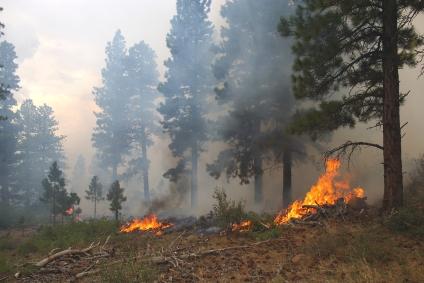 Continued dry and warm conditions in many western and southern states are expected to bring another severe wildfire season for 2013.
Continued dry and warm conditions in many western and southern states are expected to bring another severe wildfire season for 2013.
Because of this, the Insurance Institute for Business & Home Safety is urging home and business owners to take action now to effectively reduce their wildfire risk.
“Wildfire losses have been on the rise during the past couple of years in several states, with Colorado, Texas and Wyoming being particularly hard hit,” Julie Rochman, IBHS president and CEO, said in a statement. “2013 is shaping up to be another very dangerous year, because of a combination of weather-related factors.”
According the National Oceanic and Atmospheric Administration , 2012 was the warmest year on record in the contiguous U.S. The average temperature in 2012 was a full degree higher (55.3 degrees Fahrenheit) than the previous record set in 1998.
Warm temperatures were also coupled with severe drought. Last year was the driest year in the contiguous U.S. since 1988, according to the NOAA. In Nebraska and Wyoming, it was the driest year on record.
For 2013, 10 states are already experiencing “exceptional drought” conditions while snow levels throughout the country are nearing record lows, according to More than 67,000 wildfires burned more than 9.2 million acres throughout the country in 2012, according to the National Interagency Fire Center.
This was the third largest number of acres burned in the U.S. during the 13-year period of record. Warm temperatures and drought conditions will both contribute to an increase in the risk of wildfire this year.
“It is critical that individuals and communities vulnerable to wildfire act now to reduce their risks,” Rochman said. “Property owners can use our effective risk-reduction tools to build what is essentially a ‘self-defense’ system for their property during a wildfire. By doing so, they can evacuate if necessary and still hope to find their home or business intact after a fire moves through the area.”
The IBHS offers a Wildfire Home Assessment & Checklist, Wildfire Retrofit Guides and informational brochures for Residential homes, Farms and Ranches.
According to the IBHS, the goal of an effective wildfire protection plan is to keep the fire from coming dangerously close to any building on the property.
An IBHS post-fire study and other research have shown that buildings located less than 15 feet apart are particularly vulnerable to this type of fire spread. If a building has combustible siding, such as wood, vinyl or other types of plastic, good defensible space will reduce the fire hazard.
Homeowners are encouraged to think of anything surrounding or attached to a building as a potential wick that can bring flames to the house such as a deck, storage sheds or a stack of firewood.
Hard and noncombustible surfaces immediately surrounding the home, an irrigated lawn and low-lying non-woody plants are preferable to shrubs and trees. Dead plant materials should be cleared from around the home.
Within 30 feet of the home, trees and shrubs should be well spaced and maintained to eliminate “ladder fuels” that a flying ember could ignite and spread fire to the home. Storage buildings should be at least 30 feet from the residence.
Beyond 30 feet, the objective is to slow down and reduce the energy of the wildfire. Tree and brush spacing should be 10 feet between crowns to make fire harder to spread. Landscaping is also important as wildfires burn up a slope more easily than on flat ground, requiring greater setback requirements.












